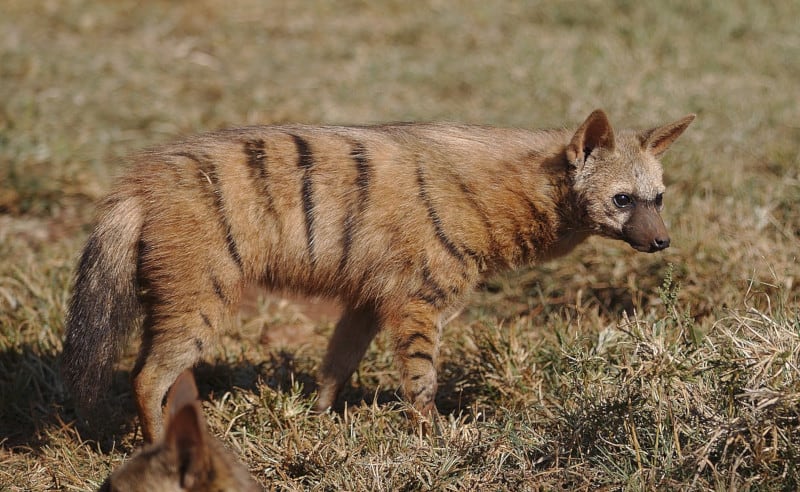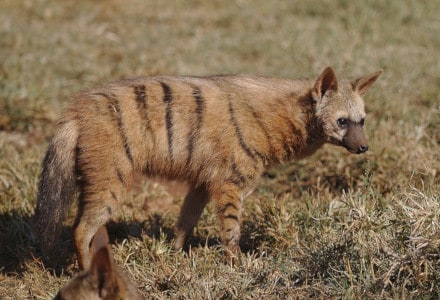
Aardwolf Facts
- Perhaps most notably, although indeed a canid, despite its common name, the Aardwolf bears no close relationship with the wolf. Furthermore, genetically speaking, this truly remarkable creature actually sits in the same Family as the hyena. In fact, a few of the alternate names for this impressive animal remains the civet hyena and the ant hyena.
- In addition, this fascinating mammal remains something of a minor mystery to researchers. That’s because it’s still unclear exactly at what point in the remote past its evolution split from the hyena. However, a quite broad time frame for this divergence in evolution does exist. Fossil evidence puts the period of this divergence at some point between 10 – 20 million years ago.
- Quite fortunately, the population of the amazing Aardwolf appears to be comparatively large. In addition, those numbers also seem to be relatively stable, at least for the moment. Therefore, the IUCN currently lists the fabulous mammal as Least Concern, on its Red List. Nevertheless, it does face potential threats to its continued existence. That’s due to the fact that, like many other species, it now faces the looming threat posed by climate change.
Related Articles
Aardwolf Physical Description
In terms of general appearance, the beautiful Aardwolf somewhat resembles a quite slender striped hyena. This physical resemblance quite understandably serves as the source of the common name. But, this remarkable mammal attains a somewhat smaller size than most hyenas. Further, it show no noticeable degree of the trait of sexual dimorphism.
Therefore, mature adults of both genders attain the same general size. Due to this, the head and body of both sexes averages a length between 22 – 31 in (55 – 80 cm). Yet, the tail, which grows extremely bushy, adds an average of 7.9 – 11.8 in (20 – 30 cm) to the overall length. Also, the shoulder height averages 16 – 20 in (40 – 50 cm). Body weights average 15 – 22 lb (7 – 10 kg).
But the Aardwolf distinguishes itself from the hyena somewhat in terms of appearance. Firstly, the muzzle develops a significantly more slender shape. Secondly, its slightly short, yellowish coat displays a number of thick vertical stripes. A comparatively long, thick mane also appears, along the middle of the neck and back. Additionally, the tip of the tail and lower legs are black.
- Kingdom: Animalia
- Phylum: Chordata
- Class: Mammalia
- Order: Carnivora
- Family: Hyaenidae
- Genus: Proteles
- Species: P. cristata
Aardwolf Distribution, Habitat, and Ecology
First of all, the sincerely stunning Aardwolf evolved as endemic to the region that now forms the continent of Africa. However, its population remains concentrated in two completely separate portions of the continent. That holds true because the animal only appears to live in areas of a few countries found in the southern and northeastern parts of the continent.
Regardless of precise geographical location, however, the animal displays decidedly certain preferences for its choice of habitat. That’s because it only appears in either bushland or areas of dry, open plains. It also avoids areas of mountains entirely, in addition to regions of intermediate forests. Thus, all regions it inhabits generally tend to be areas of relatively low elevation.
This precision of habitat evolved in connection with its food source. That’s because of yet another characteristic distinguishing it from hyenas. The remarkable Aardwolf evolved as an insectivorous carnivore. In its case, it primarily feeds on termites, consuming other insects only if it must. Further, a single individual can consume as many as 250,000 termites in one night.
Being nocturnal, and extremely shy in nature, the Aardwolf typically sleeps in its burrow during the day. It then emerges at night to feed. Most commonly, adults live as a mated pair, and raise the young together. In addition, each mated pair may have as many as 10 separate dens within their territory. Further, although territory size varies, each is marked with a substance from special glands.
Species Sharing Its Range
Check out our other articles on Breathtaking Primates of the World, Spotted Handfish, Devetashka Cave, Rafflesia arnoldii, Indian Giant Squirrel, Lord Howe Island Stick Insect

